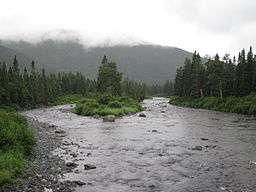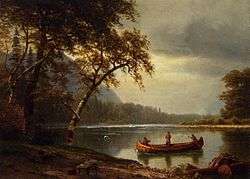Cascapédia River
| Cascapedia River | |
| Rivière Cascapédia | |
 Cascapédia River in the Gaspésie Park | |
| Country | Canada |
|---|---|
| Province | Quebec |
| Region | Bas-Saint-Laurent, Gaspésie |
| Source | Lake Cascapédia |
| - location | Mont-Albert UNO |
| - elevation | 490 m (1,608 ft) |
| - coordinates | 48°54′22″N 66°20′58″W / 48.90611°N 66.34944°W |
| Mouth | Cascapedia Bay (Chaleur Bay) |
| - location | Gesgapegiag |
| - elevation | 0 m (0 ft) |
| - coordinates | 48°11′13″N 65°54′44″W / 48.18694°N 65.91222°WCoordinates: 48°11′13″N 65°54′44″W / 48.18694°N 65.91222°W |
| Length | 120 km (75 mi) |
| Basin | 3,172 km2 (1,225 sq mi) [1] |
| Discharge | |
| - average | 82 m3/s (2,896 cu ft/s) [1] |

The Cascapédia River is a river in the Gaspé Peninsula of Quebec, Canada, which has its source at Lake Cascapedia, fed by streams of the Chic-Choc Mountains, and empties into Cascapedia Bay (Baie de la Cascapédia), a small bay of Chaleur Bay. The river is about 120 kilometres (75 mi) long. At times, it is also called Grand Cascapédia River to differentiate it from the Little Cascapédia River which empties into the same bay just to the east.
The Cascapedia is known for its Atlantic Salmon (salmo salar) fishing. With average catches of 20 pounds (9.1 kg) and a record catch of 54 pounds (24 kg), caught in 1886, the river has long been recognized as one of Quebec's richest salmon rivers. Already back in 1835, surveyor Joseph Hamel noted the abundance of fish, including trout, salmon, carp, and whitefish. Several Governors General of Canada, including The Marquess of Lansdowne and Lord Stanley, had summer homes along this river.[2][3]
The river is accessible via Quebec Route 299 that follows the river's course for 69 kilometres (43 mi). Almost its entire course is protected in the Cascapedia River Wildlife Reserve (réserve faunique de la Rivière-Cascapédia), established in 1982. Its headwaters and Lake Cascapedia are within the Gaspésie National Park.
Etymology
Its name comes from the Mi'kmaq word gesgapegiag, meaning "strong current" or "large river". It was first documented on a map by Jean-Baptiste-Louis Franquelin in 1686 as Kichkabeguiak, and appeared as Kaskabijack on a map of 1783. By 1863 Stanislas Drapeau used the current spelling.[3]
Geography
The Cascapédia River is entirely undammed and wild, and no municipality is using it for its waste water. Because its source are the Chic Choc Mountains that are largely made up of soluble limestone, its waters are rich in carbonates and low in sulfates and chlorides, with a higher conductivity and pH level than typical water of the Canadian Shield. The lack of agriculture and industry keep the river free from pollution. Its water is rated of the highest quality.[1]
The Cascapedia basin is also mostly undeveloped with less than 500 hectares (1,200 acres) under cultivation. Logging is more important: 8 percent of the basin area was harvested between 1988 and 1994.[1]
Tributaries
The significant tributaries of the Cascapédia River are (in upstream order):
- Ruisseau Blanc (White Creek)
- Ruisseau de la Truite (Trout Creek)
- Angers River
- Ruisseau Grand Nord (Large North Creek)
- Argument Creek
- Josué Creek
- Square Forks River
- Berry Creek
- Branche du Lac (Lake Branch)
- Ruisseau de l'Échouement (Stranding Creek)
- Ruisseau de Mineurs (Miners Creek)
- Ruisseau de l'Inlet (Inlet Creek)
- Brandy Creek
- Indian Creek
- Ruisseau du Dix-Septième Mille (Seventeen Mile Creek)
- Ruisseau aux Saumons (Salmon Creek)
See also
References
- 1 2 3 4 "Qualité des eaux des rivières Mitis, Matane, Sainte-Anne, York, Bonaventure, Cascapédia et Nouvelle, 1979 à 1997" (in French). Ministre du Développement durable, de l’Environnement et des Parcs du Québec. Archived from the original on 2011-02-04. Retrieved 2012-02-08.
- ↑ "Welcome to the Grand Cascapedia Salmon River and the community of Cascapedia-St. Jules.". cascapediariver.com. Retrieved 2012-02-08.
- 1 2 "Rivière Cascapédia" (in French). Commission de toponymie du Québec. Retrieved 2012-02-07.